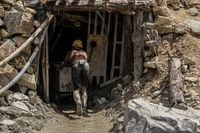Rescue operations are in full swing in northwest Colombia after a gold mine collapse on Monday, September 22, 2025, left more than 20 miners trapped underground. The incident took place at the La Reliquia mine near Segovia, in the Antioquia region—a site affiliated with Canada’s Aris Mining Corporation. As of Tuesday, officials and company representatives have confirmed that the trapped miners are alive, in good health, and receiving food, water, and ventilation as teams race against the clock to bring them safely to the surface.
According to CTV News and the Associated Press, the collapse occurred at the main shaft of the La Reliquia mine, operated by a local cooperative but within a mining block assigned to Aris Mining. Of the 23 miners confirmed trapped, five are employees of Aris Mining. The company, which has a market capitalization of approximately $1.91 billion, quickly mobilized its Brigade of Prevention and Emergency Control to coordinate the rescue alongside the local workforce. "Based on current progress, we expect the workers to be brought safely to surface within the next 24 hours," the company stated in a press release on Tuesday.
Rescue efforts have been bolstered by regular telephone communication with the miners, who are reportedly located about 80 meters below ground. The rescue teams have been able to provide essential supplies, including food, water, and fresh air, to the trapped workers. Aris Mining CEO Neil Woodyer praised the coordinated response, saying, "The safety of our people is always our highest priority. We commend the Aris Mining rescue team for their professionalism and swift, precise response." (InvestingPro).
La Reliquia is one of several small-scale mining operations that partner with Aris Mining in Colombia. The mine employs around 60 people and supplies a small portion of the ore processed at Aris’s Segovia Operations. While La Reliquia operates independently, it is located within Aris’s Segovia mining title, making the Canadian firm a key stakeholder in both the mine’s output and its safety protocols.
Mining accidents are, unfortunately, not uncommon in Colombia. The country’s mining sector is marked by a stark divide between formalized, regulated operations and a vast informal mining industry. According to the Colombian National Mining Agency, there were 124 mining-related fatalities in 2024 alone, with most incidents occurring in unlicensed or coal mines. A 2023 report by Colombia’s Human Rights Ombudsman found that more than 80% of the nation’s gold is mined by informal operators, many of whom lack proper safety measures and legal oversight. This precarious landscape has led to frequent and sometimes deadly accidents. Just days before the La Reliquia collapse, seven miners were found dead at an illegal mine in Cauca province after a nine-day search.
Yet, the La Reliquia incident stands out because it occurred at a site connected to a major international company, challenging the perception that such tragedies are limited to informal or illegal mines. Aris Mining’s involvement brings additional scrutiny to the effectiveness of safety practices, even within operations that maintain partnerships with global firms. The company has stated that La Reliquia operates outside its core infrastructure but remains an important partner for gold production in the Segovia region. In 2024, Aris Mining’s two underground gold mines in Colombia produced about 210,955 ounces of gold, contributing to the country’s total gold output of 67 tons for the year—a figure buoyed by high global prices for the precious metal.
Financially, Aris Mining presents a complex picture. The firm reported $646.78 million in revenue, with a net margin of 0.93% and an operating margin of 31.76%. While these figures indicate operational efficiency, the company’s Altman Z-Score of 1.7 places it in the distress zone, suggesting a potential risk of bankruptcy within two years. Its current ratio of 2.1 and quick ratio of 1.81 point to adequate liquidity, but the debt-to-equity ratio of 0.86 and a high P/E ratio of 314 highlight areas of concern for investors. The company’s volatility, measured at 46.08, reflects the inherent risks of the mining sector, which is subject to fluctuating commodity prices and geopolitical uncertainties.
Despite these financial challenges, Aris Mining has demonstrated a commitment to growth and modernization. In July and August 2025, the company increased its processing capacity by 50% at its Segovia Operations, raising the average milling rate from 1,971 to 2,415 tonnes per day. Additionally, a recent prefeasibility study for the Soto Norte Gold Project projects a 22-year mine life, with proven and probable reserves totaling 20.3 million tonnes at 7.00 grams per tonne of gold. These developments signal a focus on long-term sustainability, even as the company navigates the immediate crisis at La Reliquia.
The broader context of Colombia’s gold mining industry cannot be ignored. The country’s output has risen sharply in recent years, driven by high prices and increased demand. However, the dominance of informal mining operations—often run by artisanal miners or, in some cases, armed groups—has made regulatory oversight and safety enforcement a persistent challenge. The government has struggled to bring these operations into the formal sector, and tragic accidents like the one at La Reliquia serve as stark reminders of the human cost when safety protocols are insufficient or poorly enforced.
While the miners’ ordeal at La Reliquia continues, the incident has reignited debate over mining safety and corporate responsibility in Colombia. Some critics argue that international companies should exert greater influence over their local partners to ensure rigorous safety standards, even when mines operate independently. Others point out that the complexity of Colombia’s mining landscape—where legal, semi-legal, and illegal operations often overlap—makes blanket solutions difficult to implement.
For now, the focus remains squarely on the rescue effort. With communication lines open and supplies reaching the trapped miners, there is cautious optimism that all will be brought to safety soon. Aris Mining has pledged to provide regular updates as the situation develops, and Colombian authorities continue to monitor progress closely.
This incident, while harrowing, underscores the urgent need for enhanced safety measures and regulatory reforms across Colombia’s gold mining sector. As the world watches the unfolding rescue in Segovia, the miners’ plight serves as a powerful reminder of both the promise and peril inherent in the pursuit of gold.



